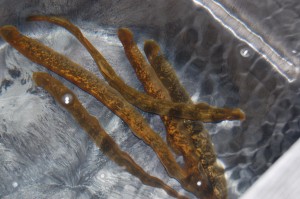Lampreys are primitive creatures – basically, tubes with teeth. Their primitive nature makes them a fascinating entry-point for studying the evolution of the immune system.
At Emory, Max Cooper and his colleagues have been studying lampreys’ versions of white blood cells. In a recent Nature paper, they show that lampreys have two kinds of cells that look very much like B and T cells in mammals, birds and fish.
Non-immunologists may shrug at this revelation.  But consider: lampreys have a completely different set of tools for fighting infections. They have proteins in their blood that glob on to invaders, but they don’t look anything like the antibodies found in mammals, birds and fish.

Lampreys in a laboratory tank. Courtesy of Masa Hirano.
Similarly, lampreys have cells that look like T Ray Ban outlet cells, in terms of some of the genes that are turned on. However, they don’t have MHC genes, which are important in human transplant medicine because they determine how and when T cells get excited and reject transplanted organs.
Lampreys are thought to be an early offshoot on the evolutionary tree, before sharks and fish, and way before critters that crawl on land. This suggests that the categories (B or T) came first even though the characteristic features of the cells (antibodies/responding to MHC) are different.
“Lampreys have the same types of cells, but they just use different building blocks to put them together,†Cooper says.
Cooper, now a Georgia Research Alliance Eminent Scholar and a member of Emory’s pathology department, made pioneering studies defining the role the thymus plays in immune development at the University of Minnesota in the 1960s. The thymus is where T cells develop and where they get their name.
He says he is now collaborating with Thomas Boehm in Freiburg, Germany to better understand the evolution of the thymus. Again, lampreys don’t have a thymus, but they may have an area next to their gills where the T-like cells develop.
John Travis at Science has a more extensive discussion of this research.
In a Darwin-anniversary essay, Travis tells the story of how the evolution of the immune system was a centerpiece of the 2005 Kitzmiller v. Dover trial, when a Pennsylviania school district’s requirement to teach intelligent design was successfully challenged.
Link to Sound Science podcast with Cooper

